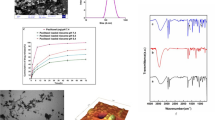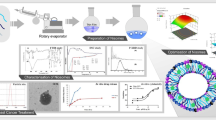Abstract
The aim, as proof of concept, was to optimize niosomal formulations of tamoxifen in terms of size, morphology, encapsulation efficiency, and release kinetics for further treatment of the breast cancer (BC). Different assays were carried out to evaluate the pro-apoptotic and cytotoxicity impact of tamoxifen-loaded niosomes in two BC cells, MDA-MB-231 and SKBR3. In this study, tamoxifen was loaded in niosomes after optimization in the formulation. The formulation of niosomes supported maximized drug entrapment and minimized their size. The novel formulation showed improvement in storage stability, and after 60 days only, small changes in size, polydispersity index, and drug entrapment were observed. Besides, a pH-dependent release pattern of formulated niosomes displayed slow release at physiological pH (7.4) and a considerable increase of release at acidic pH (5.4), making them a promising candidate for drug delivery in the BC treatment. The cytotoxicity study exhibited high biocompatibility with MCF10A healthy cells, while remarkable inhibitory effects were observed after treatment of cancerous lines, MDA-MB-231, and SKBR3 cells. The IC50 values for the tamoxifen-loaded niosomes were significantly less than other groups. Moreover, treatment with drug-loaded niosomes significantly changed the gene expression pattern of BC cells. Statistically significant down-regulation of cyclin D, cyclin E, VEGFR-1, MMP-2, and MMP-9 genes and up-regulation of caspase-3 and caspase-9 were observed. These results were in correlation with cell cycle arrest, lessoned migration capacity, and increased caspase activity and apoptosis induction in cancerous cells. Optimization in the formulation of tamoxifen-loaded niosomes can make them a novel candidate for drug delivery in BC treatment.






Similar content being viewed by others
References
Jia Y, et al. KLF4 overcomes tamoxifen resistance by suppressing MAPK signaling pathway and predicts good prognosis in breast cancer. Cell Signal. 2018;42:165–75.
Sarhadi M, Aryan L, Zarei M. The estrogen receptor and breast cancer: a complete review. CRPASE: Transactions of Applied Sciences. 06(04):309–14
Siegel RL, Miller KD, Jemal A. Cancer statistics. CA Cancer J Clin. 2016;66(1):7–30.
Shaker DS, Shaker MA, Hanafy MS. Cellular uptake, cytotoxicity and in-vivo evaluation of Tamoxifen citrate loaded niosomes. Int J Pharm. 2015;493(1-2):285–94.
Ferlay J, et al. Cancer incidence and mortality worldwide: sources, methods and major patterns in GLOBOCAN 2012. Int J Cancer. 2015;136(5):E359–86.
Schmid P, et al. Fulvestrant plus vistusertib vs fulvestrant plus everolimus vs fulvestrant alone for women with hormone receptor–positive metastatic breast cancer: the MANTA phase 2 randomized clinical trial. JAMA Oncol. 2019;5(11):1556–63.
Hanker AB, Sudhan DR, Arteaga CL. Overcoming endocrine resistance in breast cancer. Cancer Cell. 2020;37(4):496–513.
Molani S, Madadi M, Williams DJM. Investigating the effectiveness of breast cancer supplemental screening considering radiologists' bias. 2020. medRxiv, https://doi.org/10.1101/2020.12.16.20248373.
Ibrahim AB, et al. Evaluation of tamoxifen and simvastatin as the combination therapy for the treatment of hormonal dependent breast cancer cells. Toxicol Rep. 2019;6:1114–26.
Pinkerton JV. Selective estrogen receptor modulators in gynecology practice. Clin Obstet Gynecol. 2021;64(4):803–12. https://doi.org/10.1097/GRF.0000000000000647.
Barani M, et al. Evaluation of carum-loaded niosomes on breast cancer cells: physicochemical properties, in vitro cytotoxicity, flow cytometric, DNA fragmentation and cell migration assay. Sci Rep. 2019;9(1):1–10.
Birgani NB. Effect of carboplatin loaded niosomal nanoparticles on ovarian cancer cells. EC Pharmacol Toxicol. 2018;6:423–8.
Morello KC, Wurz GT, DeGregorio MW. Pharmacokinetics of selective estrogen receptor modulators. Clin Pharmacokinet. 2003;42:361–72.
Grilli G. Tamoxifen (TAM): the dispute goes on. Ann Ist Super Sanita. 2006;42(2):170.
Farrar MC, Jacobs TF. Tamoxifen. 2021 Jul 19. In: StatPearls [Internet]. Treasure Island (FL): StatPearls Publishing; 2022.
Herrscher H, Leblanc J, Petit TJBC. Agranulocytosis induced by tamoxifen in a breast cancer patient. Breast Care. 2020;15(1):72–4.
Makvandi P, et al. Drug delivery (nano) platforms for oral and dental applications: tissue regeneration, infection control, and cancer management. Adv Sci (Weinh). 2021;8(8):2004014.
Patra JK, et al. Nano based drug delivery systems: recent developments and future prospects. J Nanobiotechnology. 2018;16(1):71.
Shad PM, Karizi SZ, Javan RS, Mirzaie A, Noorbazargan H, Akbarzadeh I, Rezaie H. Folate conjugated hyaluronic acid coated alginate nanogels encapsulated oxaliplatin enhance antitumor and apoptosis efficacy on colorectal cancer cells (HT29 cell line). Toxicol in Vitro. 2020;65:104756.
Heydari Sheikh Hossein H, et al. Functionalization of magnetic nanoparticles by folate as potential MRI contrast agent for breast cancer diagnostics. Molecules. 2020;25(18):4053.
Boran G, et al. Synergistic effect of graphene oxide and zoledronic acid for osteoporosis and cancer treatment. Sci Rep. 2020;10(1):1–12.
Delfi M, et al. Self-assembled peptide and protein nanostructures for anti-cancer therapy: targeted delivery, stimuli-responsive devices and immunotherapy. Nano Today. 2021;38:101119.
Makvandi P, et al. Gum polysaccharide/nanometal hybrid biocomposites in cancer diagnosis and therapy. Biotechnol Adv. 2021;48:107711.
Day CM, et al. Novel tamoxifen nanoformulations for improving breast cancer treatment: old wine in new bottles. Molecules. 2020;25(5):1182.
Molani S, Madadi M, Wilkes WJO. A partially observable Markov chain framework to estimate overdiagnosis risk in breast cancer screening: incorporating uncertainty in patients adherence behaviors. Omega. 2019;89:40–53.
Akbarzadeh I, et al. Preparation, optimization and in-vitro evaluation of curcumin-loaded niosome@ calcium alginate nanocarrier as a new approach for breast cancer treatment. Biology (Basel). 2021;10(3):173.
Moghaddam FD, et al. Delivery of melittin-loaded niosomes for breast cancer treatment: an in vitro and in vivo evaluation of anti-cancer effect. Cancer Nanotechnol. 2021;12(1):1–35.
Amale FR, et al. Gold nanoparticles loaded into niosomes: A novel approach for enhanced antitumor activity against human ovarian cancer. Adv Powder Technol. 2021;32(12):4711–22.
Targhi AA, et al. Synergistic effect of curcumin-Cu and curcumin-Ag nanoparticle loaded niosome: enhanced antibacterial and anti-biofilm activities. Bioorg Chem. 2021;115:105116.
Moghtaderi M, et al. Enhanced antibacterial activity of Echinacea angustifolia extract against multidrug-resistant Klebsiella pneumoniae through niosome encapsulation. Nanomaterials (Basel). 2021;11(4):1573.
Jamshidifar E, et al. Super magnetic niosomal nanocarrier as a new approach for treatment of breast cancer: a case study on SK-BR-3 and MDA-MB-231 cell lines. Int J Mol Sci. 2021;22(15):7948.
Mirzaie A, Peirovi N, Akbarzadeh I, Moghtaderi M, Heidari F, Yeganeh FE, Noorbazargan H, Mirzazadeh S, Bakhtiari R. Preparation and optimization of ciprofloxacin encapsulated niosomes: a new approach for enhanced antibacterial activity, biofilm inhibition and reduced antibiotic resistance in ciprofloxacin-resistant methicillin-resistance Staphylococcus aureus. Bioorg Chem. 2020;103:104231.
Ghafelehbashi R, Akbarzadeh I, Tavakkoli Yaraki M, Lajevardi A, Fatemizadeh M, Heidarpoor Saremi L. Preparation, physicochemical properties, in vitro evaluation and release behavior of cephalexin-loaded niosomes. Int J Pharm. 2019;569:118580.
Barani M, et al. Lawsone-loaded niosome and its antitumor activity in MCF-7 breast cancer cell line: a nano-herbal treatment for cancer. Daru. 2018;26(1):11–7.
Hajizadeh MR, et al. In vitro cytotoxicity assay of D-limonene niosomes: an efficient nano-carrier for enhancing solubility of plant-extracted agents. Res Pharm Sci. 2019;14(5):448.
Ch MH, et al. Niosome-encapsulated tobramycin reduced antibiotic resistance and enhanced antibacterial activity against multidrug-resistant clinical strains of Pseudomonas aeruginosa. J Biomed Mater Res A. 2021;109(6):966–80.
Rasul A, et al. In vitro characterization and release studies of combined nonionic surfactant-based vesicles for the prolonged delivery of an immunosuppressant model drug. Int J Nanomedicine. 2020;15:7937.
Tila D, et al. pH-sensitive, polymer modified, plasma stable niosomes: promising carriers for anti-cancer drugs. EXCLI J. 2015;14:21.
Khannazer N, Paylakhi SH, Mirshafiey A, Azizi G, Motamed N. Silibinin, up-regulates chemokine receptor expression in MDA-MB-231 breast cancer cell line. Bangladesh J Medical Sci. 2015;14(2):190–5.
Khan R, Irchhaiya R. An overview on niosomes as efficient drug carriers. Int J Pharm Biosci. 2017;8:106–16.
Muzzalupo R, Tavano L. Niosomal drug delivery for transdermal targeting: recent advances. Res Rep Transdermal Drug Deliv. 2015;4:23.
Khindri S, Aggarwal G. Role of niosomes and proniosomes for enhancing bioavailability of drugs. J Drug Deliv Ther. 2015;5(1):28–33.
Akbarzadeh I, et al. Niosomal formulation for co-administration of hydrophobic anticancer drugs into MCF-7 cancer cells. Arch Adv Biosci. 2020;11(2) https://doi.org/10.22037/aab.v11i2.28906.
Rochdy Haj-Ahmad R, Elkordy AA, Chaw CS. In vitro characterisation of Span™ 65 niosomal formulations containing proteins. Curr Drug Deliv. 2015;12(5):628–39.
Li Q, Li Z, Zeng W, Ge S, Lu H, Wu C, Ge L, Liang D, Xu Y. Proniosome-derived niosomes for tacrolimus topical ocular delivery: in vitro cornea permeation, ocular irritation, and in vivo anti-allograft rejection. Eur J Pharm Sci. 2014;62:115–23.
Basiri L, Rajabzadeh G, Bostan A. α-Tocopherol-loaded niosome prepared by heating method and its release behavior. Food Chem. 2017;221:620–8.
Kassem MA, el-Sawy HS, Abd-Allah FI, Abdelghany TM, el-Say KM. Maximizing the therapeutic efficacy of imatinib mesylate–loaded niosomes on human colon adenocarcinoma using Box-Behnken design. J Pharm Sci. 2017;106(1):111–22.
Patel J, Ketkar S, Patil S, Fearnley J, Mahadik KR, Paradkar AR. Potentiating antimicrobial efficacy of propolis through niosomal-based system for administration. Integr Med Res. 2015;4(2):94–101.
Bragagni M, Mennini N, Furlanetto S, Orlandini S, Ghelardini C, Mura P. Development and characterization of functionalized niosomes for brain targeting of dynorphin-B. Eur J Pharm Biopharm. 2014;87(1):73–9.
Moghassemi S, Hadjizadeh A. Nano-niosomes as nanoscale drug delivery systems: an illustrated review. J Control Release. 2014;185:22–36.
Sadeghi S, Bakhshandeh H, Ahangari Cohan R, Peirovi A, Ehsani P, Norouzian D. Synergistic anti-staphylococcal activity of niosomal recombinant lysostaphin-LL-37. Int J Nanomedicine. 2019;14:9777–92.
Barani M, Mirzaei M, Torkzadeh-Mahani M, Nematollahi MH. Lawsone-loaded niosome and its antitumor activity in MCF-7 breast cancer cell line: a nano-herbal treatment for cancer. DARU J Pharm Sci. 2018;26(1):11–7.
Hajizadeh MR, Maleki H, Barani M, Fahmidehkar MA, Mahmoodi M, Torkzadeh-Mahani M. In vitro cytotoxicity assay of D-limonene niosomes: an efficient nano-carrier for enhancing solubility of plant-extracted agents. Res Pharm Sci. 2019;14(5):448–58.
Alemi A, Zavar Reza J, Haghiralsadat F, Zarei Jaliani H, Haghi Karamallah M, Hosseini SA, Haghi Karamallah S. Paclitaxel and curcumin coadministration in novel cationic PEGylated niosomal formulations exhibit enhanced synergistic antitumor efficacy. J Nanobiotechnology. 2018;16(1):28.
Sadeghi S, Ehsani P, Cohan RA, Sardari S, Akbarzadeh I, Bakhshandeh H, Norouzian D. Design and physicochemical characterization of lysozyme loaded niosomal formulations as a new controlled delivery system. Pharm Chem J. 2020;53:1–10.
Salem HF, et al. Evaluation and optimization of pH-responsive niosomes as a carrier for efficient treatment of breast cancer. Drug Deliv Transl Res. 2018;8(3):633–44.
Manosroi A, Bauer K. The entrapment of a human insulin-DEAE dextran complex in different compound liposomes. Drug Dev Ind Pharm. 1989;15(14-16):2531–46.
Ag Seleci D, Seleci M, Walter JG, Stahl F, Scheper T. Niosomes as nanoparticular drug carriers: fundamentals and recent applications. J Nanomater. 2016;2016:1–13.
Kanaani L. Effects of cisplatin-loaded niosomal nanoparticleson BT-20 human breast carcinoma cells. Asian Pac J Cancer Prev: APJCP. 2017;18(2):365–8.
Yazdi Rouholamini SE, Moghassemi S, Maharat Z, Hakamivala A, Kashanian S, Omidfar K. Effect of silibinin-loaded nano-niosomal coated with trimethyl chitosan on miRNAs expression in 2D and 3D models of T47D breast cancer cell line. Artif Cells Nanomed Biotechnol. 2018;46(3):524–35.
Funding
This work was partly supported by the Bahar Tashkhis Teb, (BTT9903) and the Ministry of Science and Higher Education of the Russian Federation within the framework of state support for the creation and development of World-Class Research Centers “Digital biodesign and personalized healthcare” (N. 075-15-2020-917).
Author information
Authors and Affiliations
Contributions
I.A. and M.F. performed the experiments and data collection and drafted the manuscript. M.J., N.Z., B.S., M.K.A, P.T., N.H., and P.M. and contributed to the development of the concept, study design, and critically reviewed the manuscript. A.S., H.N., and H.A.A. contributed to study design, data collection, and data analysis and drafting the results. M.V. developed the concept, contributed to data analysis, critical reviewing and approval of the manuscript, and financially supported the project.
Corresponding authors
Ethics declarations
Conflict of interest
The authors declare no competing interests.
Additional information
Publisher’s Note
Springer Nature remains neutral with regard to jurisdictional claims in published maps and institutional affiliations.
Rights and permissions
About this article
Cite this article
Akbarzadeh, I., Farid, M., Javidfar, M. et al. The Optimized Formulation of Tamoxifen-Loaded Niosomes Efficiently Induced Apoptosis and Cell Cycle Arrest in Breast Cancer Cells. AAPS PharmSciTech 23, 57 (2022). https://doi.org/10.1208/s12249-022-02212-0
Received:
Accepted:
Published:
DOI: https://doi.org/10.1208/s12249-022-02212-0




